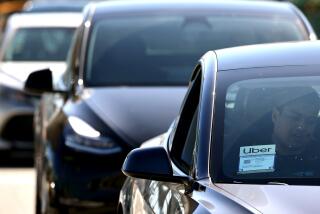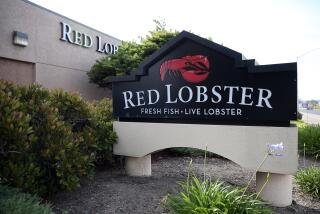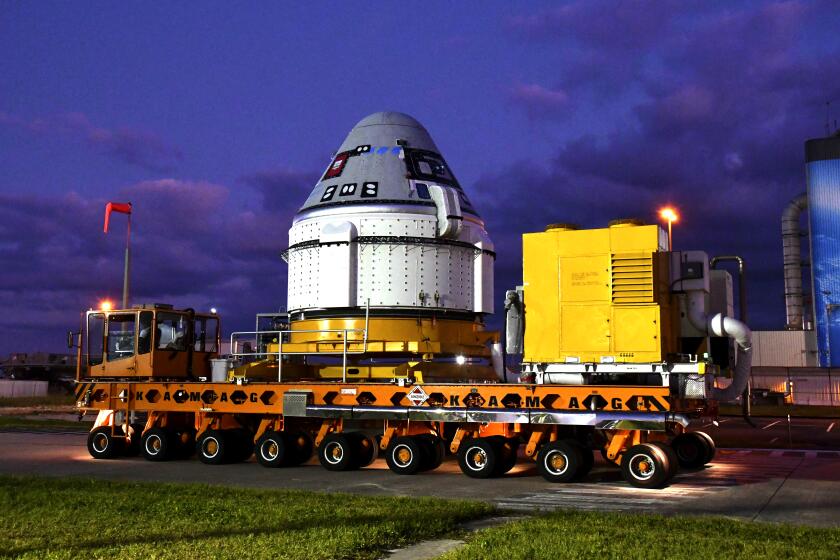City Would Emerge Fully Formed From Valley
On a good night, a fast driver can make it from downtown Los Angeles to the San Fernando Valley in 15 minutes, gliding across the slight rise of the Cahuenga Pass, pink neon from Universal Studios on the right and Ventura Boulevard--the Valley’s “Main Street”--angling off to the left.
This is the entrance to what could become the unexpected city. If voters approve Valley secession Nov. 5, they would create a major American city fully formed from another municipality, starting life with a built-in population of 1.35 million and an economy bigger than that of some states.
For the record:
12:00 a.m. June 5, 2002 For The Record
Los Angeles Times Wednesday June 05, 2002 Home Edition Main News Part A Page 2 National Desk 10 inches; 367 words Type of Material: Correction
*
Sen. Alarcon--A story about San Fernando Valley secession in Section A on May 26 misidentified Richard Alarcon as an assemblyman. Alarcon is a member of the state Senate.
It would be the sixth-largest city in the nation, by updated census rankings, edging past Phoenix and trailing New York, Chicago, a newly downsized Los Angeles, Houston and Philadelphia.
“The Brady Bunch” and Valley girls notwithstanding, the identifying markers of a Valley city would be quite different from the region’s image as America’s suburb.
Its population would be 43% Latino, 41% white, 9% Asian/Pacific Islander and 4% African American.
Rather than a traditional downtown, it would have Ventura Boulevard, whose shops, cafes and high-rises stretch the length of the Valley.
Cooler in winter and hotter in summer than most of the rest of Los Angeles, the arrowhead-shaped Valley city would cover 222 square miles. It would hug two mountain ranges and include a long stretch of the Los Angeles River, which courses through the 2,100-acre Sepulveda Dam Recreation Area.
The new city would have its own economic and business centers, a polyglot population, a built-in political class and a strong tradition of local philanthropy. It would lack major medical centers, leading universities, museums and tourist destinations.
Its richest person would be Michael Milken, the disgraced former junk-bond king turned philanthropist, worth $800 million.
Its largest private employer: defense contractor Boeing North American Inc., with 5,000 employees.
Its kingmakers include David Fleming and Bert Boeckmann, wealthy backers of the secession movement. It would generate 600,000 jobs and $50 billion in goods and services annually, according to the Los Angeles Economic Development Corp. Biotechnology and medical technology companies would have a strong presence and the Valley would keep its thriving service sector.
But its biggest business would be entertainment, which pays its workers $4 billion each year and makes everything from children’s cartoons to pornographic videos.
Warner Center, built on the site of the old Warner Bros. ranch in Woodland Hills, is the Valley’s version of Century City.
Here, where the movie company filmed many of its westerns, several of the region’s large health insurers have offices in high-rises clad in mirrored tiles that look blue and cool, even in the Valley sun.
“This area? It’s all city. It’s all businesses here,” said bartender Medhat Mikhail, who commutes up to 21/2 hours to get from his home in Paramount to his job at the Warner Center Marriott.
*
Van Nuys Would Become Civic Center
Across the belly of the Valley, running north from the Santa Monica Mountains to the Santa Susanas, is Van Nuys Boulevard, home to what was once its downtown.
Smack in the middle, across the street from an adult bookstore and a bail bondsman, sits a complex of courthouses and civic buildings that would serve as the seat of government for a Valley city.
North on Van Nuys, neighborhoods that once epitomized suburban life are now among the most urbanized in the Valley.
The community of Van Nuys, which includes the civic center, is home to some of the Valley’s poorest and most dangerous areas. Graffiti dots the walls and dirty mattresses lie in front of some of the houses on Blythe Street, where gangs have terrorized residents for decades.
Across Van Nuys Boulevard is a shopping center known as the Plant, a bit of urban renewal built on the site of a General Motors plant that drew workers to the Valley after World War II.
Apartment buildings have high fences around their parking lots and signs saying that the buildings are not open to the public.
Life in the area “has been quiet so far,” said Alvin Montano, who operates a hot dog stand in the broad courtyard of the civic center and lives in a nearby apartment.
But there were 2,000 arrests in the Van Nuys Division for what the Los Angeles Police Department calls serious crimes--including 19 homicides--in 1999, the last year for which the department has broken down statistics.
Crime edged up in the Valley last year, from 42 reported crimes per 1,000 residents to 44, said Daniel R. Blake, professor of economics and director of the San Fernando Valley Economic Research Center at Cal State Northridge. Similar figures are not available for the part of Los Angeles that would remain if a new Valley city is formed, but FBI statistics show a slight rise in overall crime throughout the city over the last few years.
“I prefer to work here, but not live here,” said Herman Tucker, who moved his family out of Van Nuys six years ago. “It’s too crowded and crime-ridden around here in Van Nuys, and everywhere else [in the Valley] is too expensive.”
Even though there are both rich and poor in the Valley, most people fall somewhere in the middle. The Valley has 33,000 households making less than $10,000 a year and 21,000 making more than $250,000. The remaining 86% of the households fall in between.
Bob Scott, a consultant and co-founder of the powerful Economic Alliance of the San Fernando Valley, grew up in Panorama City, a planned community of modest houses just north of the GM plant, where thousands of families moved after the war.
“When we first moved out to Panorama City, this was the community of the future,” Scott said.
“It was 1954; I would have been 8,” he said. “And there was the General Motors plant, which seemed like it was out in the country. And they had this Panorama Market, and I don’t think I’d ever seen a supermarket before. It was filled with promise.”
It was years before Scott realized that Panorama City wasn’t a city at all.
“I don’t know how old I was before I realized I lived in the city of Los Angeles,” he said.
*
Long-Standing Feeling of Separateness
The remoteness of the Valley in those days is key to understanding its culture, politics, business structure, and most of all, the sense of separateness that has fueled the secession movement.
The region, then home to wheat fields, ranches and a few settlements, joined Los Angeles in 1915, thirsty for water that the big city had brought down from the Owens River in its 2-year-old Los Angeles Aqueduct.
But within the decade, Valley residents were complaining that the marriage didn’t suit them.
“By the 1920s, the Valley was screaming about poor services and no representation,” said Steve Erie, a professor of political science at UC San Diego. “It was true.”
When Ruth Richter, 79, moved to Winnetka in the West Valley in 1950, only one bus connected the Valley to downtown Los Angeles--and that was miles away in Van Nuys.
If you did manage to get to Van Nuys to catch that bus, you had to be finished with your business early--because the line shut down at 7 p.m.
Burglars looted several houses in Canoga Park one winter, knowing that their occupants and the Valley’s sole police officer were at a parade.
*
Business Leaders Back Secession Movement
Many of the business leaders, who form what some jokingly refer to as the Valley’s shadow government, support the pro-secession group Valley VOTE. “The Valley VOTE movement is supported by two fairly powerful interest groups--the homeowner associations and the chamber of commerce folks,” said Tom Hogan-Esch, who teaches political science at Cal State Northridge and has studied the secession movement.
“These are going to be the organizational and interest-group backbone of the new Valley city for some time to come. These are going to be the powerful players in the new Valley city,” he said.
One of those is attorney David Fleming of Studio City.
A philanthropist who gave $1 million to Valley Presbyterian Hospital in Van Nuys, Fleming bankrolled secession activists and is a founder of the Economic Alliance of the San Fernando Valley.
He had Richard Riordan’s ear while the former mayor was in office. City Council members and county supervisors consult with Fleming when dealing with an issue affecting the Valley or Valley business.
Bert Boeckmann, a Fleming friend whose North Hills Ford dealership, Galpin Motors, is the largest in the nation, is also a heavy donor to local causes. With Fleming, he contributed funds to start Valley VOTE, the organization that pressed to put secession on the ballot.
Within the secession movement, they are joined by Richard Close, president of the Sherman Oaks Homeowners Assn. and chairman of Valley VOTE.
Close was also a key player in the movement behind Proposition 13, which rolled back property taxes in California.
It is less clear, however, who would hold elective office in a new city.
*
List of Possible Mayoral Candidates
Among likely candidates for mayor are Richard Alarcon, a former Los Angeles city councilman who is being forced out of his East Valley Assembly seat by term limits, and Keith Richman, a Granada Hills physician who is serving his first term in the Assembly.
Former Assembly Speaker Bob Hertzberg (D-Sherman Oaks), who carried the legislation that made a secession vote possible, insists he is not interested in running.
Former Assemblyman Richard Katz of Sylmar is also frequently mentioned as a possible mayoral contender, but he is chairing the pro-secession political campaign and says that he is not running.
At play in Valley politics is a mix of demographics, past alliances and voting trends.
A Valley city would have more minorities than whites. Five of its 14 City Council districts have been drawn to maximize Latino voting strength. But the overwhelming majority among registered voters, 68%, is white. Latinos, even though they would be the largest ethnic group, would account for just 19% of registered voters. Blacks and Asians would each comprise about 5% of the voters.
“At least for the next generation, you’re going to have an electorate that is dominated by the Anglo vote,” said Hogan-Esch. “It’s anybody’s guess after that.”
Huge as it might be, a Valley city would lack some significant cultural institutions typically found in large municipalities.
There is no music center, no philharmonic. There is no baseball team.
A list of the top 20 tourist attractions for visitors to the Valley, compiled by the Economic Alliance of the San Fernando Valley, does not include a single site that’s located there. Even Universal Studios would be outside the new city’s limits.
But people find other reasons to visit the Valley.
There’s Antique Row in Canoga Park, where vintage shops reinvented themselves after the 1994 Northridge earthquake; the Encino’s Farmers Market; the Valley Village mural; summer concerts in Warner Park; the original mission in Mission Hills.
And in North Hollywood, where a jumble of artsy shops and cafes has sprouted in a redevelopment area aimed at attracting entertainment businesses, Practical Props stocks several thousand light fixtures for use in movies and television--and for sale to anyone who wants a pair of perfect pink lamps from the 1950s.
Last week Rosie Tupta, who lives in the Mid-Wilshire area, was in the store, combing it for what Hollywood no longer offers her. “I always shop in the Valley,” Tupta said. “Hollywood doesn’t have the prop houses it used to have. I just hop over the hill and I’m here.”






